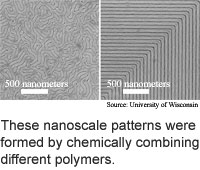
Self-assembly goes around bends
Many researchers are working on the idea
of self-assembly -- coaxing materials to assemble at the molecular level.
Self-assembly could someday be used to build nanoscale structures and
to build materials molecule-by-molecule.
Researchers from the University of Wisconsin at Madison, the Korea
Advanced Institute of Science and Technology, and the Paul Scherrer Institute
in Switzerland have taken the idea to step forward with a way to make
polymer chains automatically assemble in non-regular patterns, including
sharp angles. The method could eventually be used to build precise features
as small as ten nanometers -- the length of a row of 100 hydrogen atoms.
Existing polymer self-assembly methods are able to form patterns,
but are limited to making arrays of dots or straight lines. The new method
makes for more precise patterns, includes the ability to make less regular
features, and is very precise, according to the researchers. They produced
patterns with 50- to 80-nanometer-wide parallel lines that contained bends
of 45, 90 and 135 degrees.
These patterns can be oriented precisely on chips, and could be
used to make computer circuits that are smaller than those made using
today's silicon technology, according to the researchers.
The key to the method is a mix of polymers and a nanoscale template.
To make the patterns, the researchers mixed block copolymers, or pairs
of polymer chains connected at one end, and homopolymers, or single polymer
chains so that they self-assembled into structures on chemically nano-patterned
templates.
They made the patterns by coating a silicon wafer with a light-sensitive
plastic and using light and chemicals to etch an initial pattern of lines.
They then etched away the lines to a flat surface whose surface chemistry
still followed the initial pattern. The last step was to apply the blend
of polymers to this surface; the block copolymer covers the areas where
the lines had been and the homopolymer covered the remaining areas.
The method could be used practically in five to ten years, according
to the researchers. The work appeared in the June 2, 2005 issue of Science
(Directed Assembly of Block Copolymer Blends into Nonregular Device-Oriented
Structures).
Stories:
TRNís Top 10 Stories
Letter to Readers
Briefs:
Invisible ink is rewritable
Light powers biochip gears
Self-assembly goes around bends
Magnetics drives particle patterns

Research Watch blog
View from the High Ground Q&A
How It Works
RSS Feeds:
News
Ad links:
Buy an ad link
Ad links: Clear History
Buy an ad link
|
TRN
Newswire and Headline Feeds for Web sites
|
© Copyright Technology Research News, LLC 2000-2010. All rights reserved.